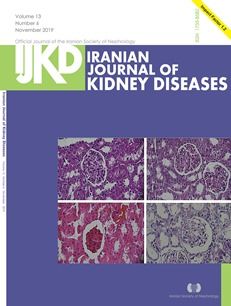The Role of Urinary Angiotensinogen in Kidney Interstitial Inflammation and Renal Prognosis
Abstract
Introduction. Urinary angiotensinogen (uAGT) has been described as a novel biomarker of acute kidney injury (AKI) and chronic kidney disease (CKD). Renal interstitial inflammatory cell infiltration is a common renal pathological feature of AKI and CKD. However, the correlation between uAGT and renal interstitial inflammatory cell infiltration is unknown. The aim of this study was to analyze the expression of uAGT, its relationship with interstitial inflammatory cell infiltration, and prognosis in patients with renal insufficiency.
Methods. The expression of uAGT, urinary kidney injury molecule 1 (uKIM-1), and urinary neutrophil gelatinase-associated lipocalin (uNGAL) were examined by enzyme-linked immunosorbent assay (ELISA) at baseline and kidney pathology was evaluated at the same time.
Results. Sixty-five patients with renal insufficiency and 12 healthy controls were enrolled. uAGT, uKIM-1, and uNGAL levels were significantly higher compared with healthy participants. uAGT showed the strongest correlation with interstitial inflammatory cell infiltration (r = 0.366, P < .05). uAGT level was able to identify interstitial inflammatory cell infiltration with greater accuracy (AUC = 0.664, P < .05) than other urinary biomarkers. After a median follow-up of 22 months, 15 patients reached the composite renal endpoint. Kaplan meier survival curves followed by multivariate cox proportional hazards regression analysis showed that uAGT (> 166.8 ng/mg creatinine) independently predicted higher risk of the endpoint.
Conclusion. uAGT may be used as a non-invasive biomarker of interstitial inflammatory cell infiltration and a strong predictor of renal prognosis in patients with renal insufficiency.


